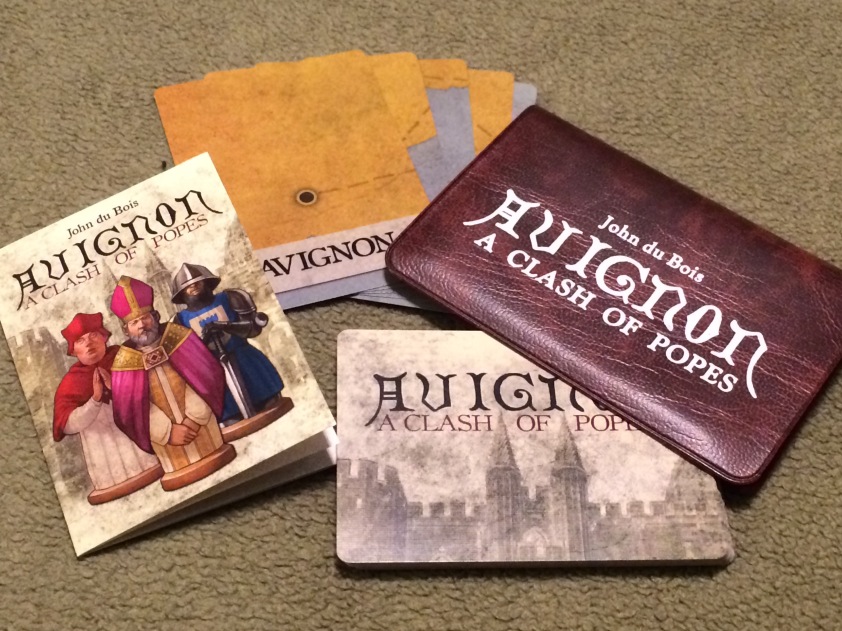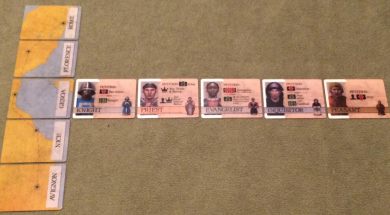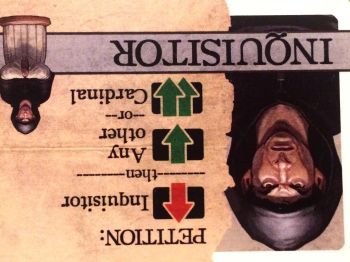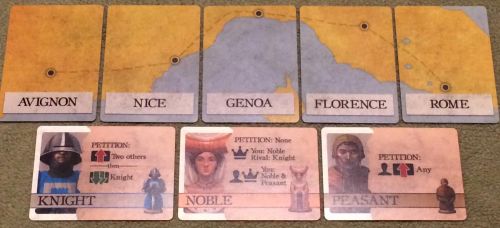 Designer: John du Bois
Designer: John du Bois
Artist: Fabrice Weiss
Publisher: Button Shy Games
Players: 2
Playing Time: 5 – 15 minutes
Complexity: light/fun
Random Interference: low
Components: A
Aesthetics: A
Overall: B
(For general information on my ratings systems, CLICK HERE.)
Short & Sweet:
It’s a card-based, chess-like micro-game that quite literally fits unobtrusively in your pocket. It’s more interesting than checkers but not nearly as involved as chess, and you can play it comfortably in short stints in a wide range of settings.
Some Background Info You Probably Don’t Care About:
I don’t know why, but I’ve always loved “pocket” or “travel” games. The oldest one (or at least my favorite one) from my childhood was a little thing called Dragon Master. It was a simple, fantasy-themed roll-and-move dungeon crawler, and it was part of Milton Bradley’s Flipsiders series: pocket-sized, magnetic games that folded up into plastic shells “disguised” as audio cassettes. (As kids we just love the idea of “disguising” things, no matter how obvious the ruse… ahemTransformers.) I don’t know what ever happened to this game—probably ended up in a yard sale or Goodwill at some point, but I played it to death back then.
 I don’t know if it’s the shinnichi in me that just loves miniaturization of things, or if it’s simply the convenience of being able to tote around small-box and travel-ready games for impromptu play. Probably both. My backpack in high school was laced with these kinds of games: travel Battleship, Express Monopoly, and a small, hand-drawn copy of Nine Men’s Morris were just a few titles that regularly hit the desks between (and during) classes. I was also working on one of my earliest game designs back then: it was going to be a solitaire D-Day game with a board small enough to fit on a school desk. It never got very far, and there are several titles now that have done the job better than I was going to, but the point stands: I love small footprint, ready-to-play games.
I don’t know if it’s the shinnichi in me that just loves miniaturization of things, or if it’s simply the convenience of being able to tote around small-box and travel-ready games for impromptu play. Probably both. My backpack in high school was laced with these kinds of games: travel Battleship, Express Monopoly, and a small, hand-drawn copy of Nine Men’s Morris were just a few titles that regularly hit the desks between (and during) classes. I was also working on one of my earliest game designs back then: it was going to be a solitaire D-Day game with a board small enough to fit on a school desk. It never got very far, and there are several titles now that have done the job better than I was going to, but the point stands: I love small footprint, ready-to-play games.
Modern designers are becoming increasingly creative at compressing rich, thought-provoking game systems into tiny packages, and it’s quite the art form. I’m working on one myself, and it’s no easy thing to concentrate so much goodness in so small an area and/or with so few pieces. We’ve come to dub the smallest of these titles “micro-games,” and for the tiny-game lover like me, they’re basically crack, since they come at such preposterously low prices. You can therefore imagine that when I came across Jason Tagmire’s Kickstarter for Avignon—a game like chess with a theme of religious conflict that fits in your pocket and is literally being branded as one in a series of “Wallet Games,” which could be mine for only $8—well… let’s just say I backed this micro-game in about a microsecond.
Play Summary
 Five “map cards” are laid out in a line along the side of the play area and with the two opponents at either long end. Graphically and thematically, they depict 5 cities along the Mediterranean coast from Avignon to Rome (inclusive). Functionally, however, they serve to define the horizontal axes of an imaginary 5×5 grid on which the game will take place. Five random character cards are then dealt along the center horizontal row, each now occupying and defining one of the imaginary vertical axes. The remaining character cards are set aside as a draw pile.
Five “map cards” are laid out in a line along the side of the play area and with the two opponents at either long end. Graphically and thematically, they depict 5 cities along the Mediterranean coast from Avignon to Rome (inclusive). Functionally, however, they serve to define the horizontal axes of an imaginary 5×5 grid on which the game will take place. Five random character cards are then dealt along the center horizontal row, each now occupying and defining one of the imaginary vertical axes. The remaining character cards are set aside as a draw pile.
Not counting the rare expansion cards that were promotional and supplemental to the Kickstarter campaign, there are nine possible character types (2 copies of each in the deck) who might come into play: bishop, cardinal, evangelist, guildmaster, inquisitor, knight, noble, peasant, and priest. Players alternate turns. On your turn, you must perform, once each, any two of the following four actions:
- Beseech: pull a card one position on the grid towards you.
- Chastise: push a card one position on the grid away from you.
- Excommunicate: discard a character card and replace it with a new draw from the deck.
- Petition: invoke the unique movement instructions of one of the characters, which are listed on the character’s card. Many of these provoke multiple moves in multiple directions by multiple characters.
A character card only ever moves forwards and backwards along the vertical axis where it spawned. In short, you win if you can pull three cards off the 5 x 5 grid and onto your side of the table, thematically called your “congregation.” There are a few exceptions to this victory condition, whose special circumstances are stated on the relevant cards, but in any case, the objective is a tactical one. The game play is a five-lane tug-of-war representing the attempts by rival popes (the players) to garner the favor of these characters. The whole dance plays out between 5 and 15 minutes.
What Doesn’t Work So Much for Me:
- Orientation/perspective problems. Each character card with a special “petition” move is marked with directional arrows and simple annotations to help the players quickly interpret what the unique move is. This fact, in itself, is helpful, but the problem is the arrows will naturally be upside-down to one of the two players. I wasn’t personally troubled by it, but I can easily see this being a source of confusion, causing mistakes in a
player’s thought process and diminishing their enjoyment of the game. The designers were cognizant of this problem. A notes section at the end of the rules offers that players can rotate the cards on their turn (annoying to have to constantly do this), and/or to make use of a provided player-aid card which summarizes the moves (adds an extra layer of translation when trying to calculate tactics). Alternatively, the rules offer that the players could orient all the cards sideways, and the flip-sides of the map cards can be joined by their long ends to adjust the aspect ratio of the 5×5 grid. Unfortunately, this only results in the arrows pointing the wrong direction for both players, and isn’t a much more satisfactory solution. Honestly, I can only envision two possible solutions: (a) using figurines or standees instead of cards, which would have defeated the entire concept of the micro-/wallet-game, leaving us only (b) ambigramic cards, which most likely would have made the cards too busy and would have diminished the artwork. Fortunately for me, and hopefully for you, the orientation issue will not be a major hardship.
- Anti-climatic victories. It’s really nice that you can get a whole game in under 15 minutes, and if you enjoyed it, you can shuffle and deal a new hand in seconds. But the drawback to this is that victory/defeat can come quite suddenly and after only a few moves. It can feel cheap to the loser and un-gratifying to the victor. If all you’re really looking for is a “quick fix,” this isn’t really an issue. However, if you want something a little longer-lasting with a greater sense of reward, I would suggest increasing the number of cards needed to claim a victory, and possibly even turning two extra cards face down at either end of the map cards, building a 5×7 grid and making it more challenging to actually bear off. (I haven’t play-tested either one of these suggestions; just spit-balling here.)
What’s Really Great:
- Artwork. The artwork is very handsome and brings out both the theme and the chess-like mechanics in a great way. In addition to a close-up portrait of the characters on each card, Fabrice Weiss went so far as to also depict them as chessmen, which is really clever. The map cards are clean and attractive, and the style overall exudes a very Borgian grit. Honestly there isn’t a thing I’d change about the artwork, which is why I couldn’t realistically imagine an ambigramic layout working without crowding the card. This level of beauty is not something to which we’ve been treated in the past when it came to “travel” games. Most such things were unattractive, slightly clunkier versions of their full-size parents, or they were ugly stick-man games we drew with our own sub-par artistry. Avignon is a game whose visual appeal stands entirely on its own merit, and is in fact more visually attractive than a great many “full size” board games.
- Portability. Avignon delivers what it promises. It’s a serious game in a very small package that can hit the table in a matter of seconds just about anywhere you are. It’s quick to teach and easy to learn, making it accessible to anybody with whom you might be paired up. I can see this being a great idling game for times when you’re sitting in that long line for the next Star Wars film, or at a restaurant waiting for the order to arrive. (And with the short hands, it’s easily added to one’s list of “drinking games”…)
Final Remarks:
One thing that may work against Avignon is that it is only for 2-players, and it might not get to the table if you’ve got too many companions, or if the one companion you have is not much of a fan for chess-likes. For me, that constant partner is my wife, and she really doesn’t care for that kind of a tone all that often. In fact she abhors chess itself. Our most popular 2p go-to is Patchwork, which we play via the iOS app. When she is in the mood for something “thinky” and abstract, she and I are more likely to play …and then, we held hands. For something portable and light-hearted, we’ll sometimes play Oddball Äeronauts. And due to the somewhat anti-climatic endings that sometimes occur in Avignon, when I do get that rare opportunity to play one-on-one with someone who enjoys a chess-like experience, I’m most likely going to make a bid for Onitama as my first choice.
However, Avignon is a solid game and a worthwhile addition to your library. It is not at all precluded by the other titles I mentioned (variety is the spice of life, after all), and it boasts a level of convenience that I’ve not seen paralleled in any compact game, ever. I am regularly beset by unexpected opportunities to get some gaming in, only to be foiled by the fact that I’m not “packing.” Such missed opportunities do not happen nearly as frequently now, as I have literally had my Avignon wallet with me in my backpack (which I tote daily) every single day since it arrived in my mailbox. For a guy who used to load more travel games than textbooks into his school bag, and who used to obsess over Flipsiders, Micro Machines, and hand-held LCD games, Avignon is a great fit for me.
You are invited to subscribe to this blog feed and/or to leave comments using the forms below. If you enjoy what we produce here at Past Go, please consider becoming a patron of ours on Patreon. Even the smallest donation is gratefully received. May you be happy.





Interesting theme and concept. Thank you for your thoughts!
LikeLiked by 1 person
You’re welcome. Thanks for reading!
LikeLike
cool blog!! have you shared your thoughts on any gaming sites?
Marie
LikeLiked by 1 person
Thanks for reading! I do post all my game reviews on the corresponding page at boardgamegeek.com. 🙂
LikeLike
oh ok gotcha. well if you’re also interested in posting for Now Loading, check out our site and if you like what you see, shoot me an email! marie@nowloading.co
Cheers!
LikeLike